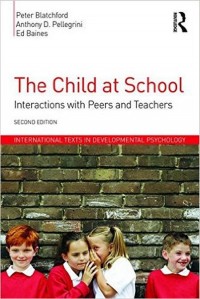
Text
The child at school : interactions with peers and teachers
About the Book
What is the nature of children’s social life in school?
How do their relationships and interactions with peers, teachers and other school staff influence their development and experience of school?
This book, written by leading researchers in educational and developmental psychology, provides answers to these questions by offering an integrated perspective on children’s social interactions and relationships with their peers and teachers in school. Peer interactions in school have tended to be underestimated by educationalists, and this book redresses the balance by giving them equal weight to teacher–child interactions.
In this second edition, the authors extensively revise the text on the basis of many years of research and teaching experience. They highlight common misconceptions about children, their social lives, and school achievement which have often resulted in ineffective school policy. The book includes a number of important topics, including:
- The significance of peer-friendships at school
- The nature and importance of play and break-times
- Aggression and bullying at school
- Peer relations and learning at school
- The classroom environment and teacher-pupil interaction
- The influence of gender in how children learn at school.
- Advantages and disadvantages of different methodological approaches for studying children in school settings
- Policy implications of current research findings.
The Child at School will be essential reading for all students of child development and educational psychology. It will also be an invaluable source for both trainee and practicing teachers and teaching assistants, as well as clinical psychologists and policy makers in this area.
Table of Contents:
1. An Introduction to The Child at School
2. Children’s social competence and peer relations
3. Pupil friendships in school
4. Children’s Play
5. Breaktime/Recess in school
6. Aggression in school: the specific case of bullies and victims
7. Peer Relations and School Learning
8. Classroom environments
9. Adult-pupil Interactions in the classroom
10. Teacher expectations
11. Differences in classroom interaction in relation to gender
12. A concluding note
For more information:
https://goo.gl/OwpOJz
Ketersediaan
| 153000423 | 372.18 BLA c | Perpustakaan Pusat UIN | Tersedia |
Informasi Detail
- Judul Seri
-
International texts in developmental psychology
- No. Panggil
-
372.18 BLA c
- Penerbit
- New York : Routledge., 2016
- Deskripsi Fisik
-
ix, 308 p.; 24 cm
- Bahasa
-
English
- ISBN/ISSN
-
9781848723009
- Klasifikasi
-
372.18
- Tipe Isi
-
-
- Tipe Media
-
-
- Tipe Pembawa
-
-
- Tahun
-
2016
- Edisi
-
2
- Subjek
- Info Detail Spesifik
-
-
- Pernyataan Tanggungjawab
-
-
Versi lain/terkait
Tidak tersedia versi lain
Lampiran Berkas
URl Source
Komentar
Anda harus login sebelum memberikan komentar
 Karya Umum
Karya Umum  Filsafat
Filsafat  Agama
Agama  Ilmu-ilmu Sosial
Ilmu-ilmu Sosial  Bahasa
Bahasa  Ilmu-ilmu Murni
Ilmu-ilmu Murni  Ilmu-ilmu Terapan
Ilmu-ilmu Terapan  Kesenian, Hiburan, dan Olahraga
Kesenian, Hiburan, dan Olahraga  Kesusastraan
Kesusastraan  Geografi dan Sejarah
Geografi dan Sejarah